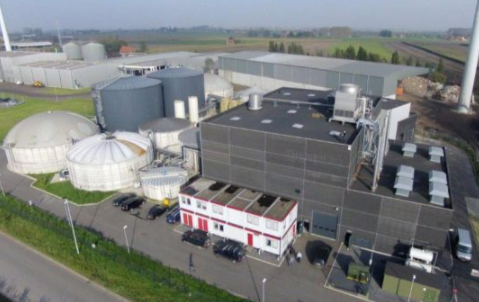Waterleau New Energy, BE (Demonstration plant)

Visit their website, read the factsheet, explore an illustration of the technology, process and products and watch the video – available in English and Flemish.
Plant description: Waterleau NewEnergy (Ieper) operates a biogas plant in West Flanders, a region characterised by intensive pig husbandry, and therefore needs to cope with a manure surplus and stringent local fertilising legislation. The feedstock ration consists of 45% manure and 55% organic residues from agro-food industry.
Innovations: Waterleau NewEnergy had already invested in an advanced digestate treatment line. Digestate is separated into a dried solid fraction. The liquid fraction is further treated by means of an evaporator where ammonium is removed and recovered as condensed ammonia water. Condensed water is purified through reverse osmosis (RO). The remaining concentrate of the evaporator is low in ammonium but contains other macro-nutrients. Other innovations include blending of the dried solid fraction and evaporator concentrate producing tailor-made organic fertiliser products with N-P-K ratios in accordance to farmers demands.
Mass- and Energy balances: Specific biogas production (150 m3/tonne of feedstock) is high due to the intake of organic residues from food industry. Biogas is converted into 21,300 MWh of electricity of which 70% is fed to the grid and the remainder used on-site. Thermal heat produced by the combined heat and power (CHP) generator is used on-site to meet the energy demand of the dryer and evaporators.
By means of a decanter, 75% of phosphorus is recovered in the solid fraction which is subsequently dried to solid organic fertiliser with 90% dry matter. The liquid fraction is treated in an evaporator which effectively separates one tonne of liquid fraction into 0.14 tonnes of concentrate, 0.015 tonnes of condensed ammonia water 0.85 tonnes of condensed water. Condensed water needs post-treatment by RO in order to meet criteria for discharge. Chemicals consumed include polymer for solid/liquid separation and sulphuric acid for nitrogen recovery on the RO.
End-products & Agronomic quality:
- Dried solid fraction (92% dry matter) can be effectively transported over long distances. It is sold in France as an organic P fertiliser.
- Condensed ammonia water (93 g N/kg) is a suitable alternative for urea or synthetic ammonia water in DeNoX installations for treatment of flue gasses. However, it is unsuitable as an N fertiliser because of its high pH.
- Evaporator concentrate, remaining after evaporation of water and ammonia, is high in K (25 g K/kg), N (11 g N/kg) and S (12 kg S/kg). Concentrate has to compete with disposal of animal manure due a high fraction of N being present in organic form and a rather high P content.
- To improve its business case, WNE is now blending dried solid fraction with evaporator concentrate. This blend is a wanted fertilizer is France.
Environmental benefits: WNE converts organic residues into green energy and biobased fertilisers thereby recycling (non-renewable) elements including P. Energy demand of their process is fully covered by energy production from biogas (electricity and thermal heat). Use of condensed ammonia water in industry avoids ammonia emissions from use as fertiliser.
Business Case:
- The dryer and evaporator have a high thermal energy demand and this concept is therefore only applicable to AD plants treating feedstocks with a high biogas production.
- WNE has long-term contracts for disposal of end-products to France where there is demand for these types of organo-mineral fertilisers. For disposal of ammonia water however, they rely on acceptance of one buyer. To reduce this dependency, they also consider shifting to production of ammonium sulphate for use as a fertiliser.
Outlook: The installation at Waterleau NewEnergy is performing according to their expectations. They however look into opportunities to increase the profitability of the business case, more specially at increasing revenues from the sale of their end-products. To improve its flexibility in terms of end users, WNE is exploring options to convert ammonia water into ammonium sulphate for use as a RENURE fertilising product.

